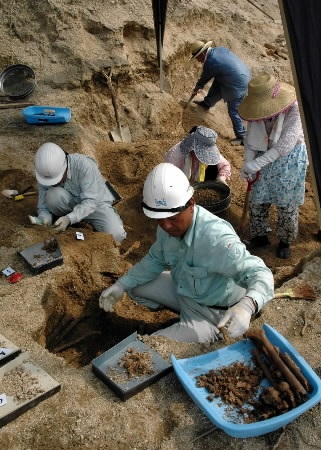Ninoshima Island, Awakening from Slumber, Part 4
Jun. 28, 2010
Residents work to return remains to families
by Kunihiko Sakurai and Aya Kano, Staff Writers
Fifty-nine years after the dropping of the atomic bomb [this series was originally published in July 2004], the remains of many atomic bomb victims are being found on Ninoshima, a small island off the coast of Hiroshima. The fact that they are just now being exhumed reveals the vast scope of the devastation wrought by the bombing. The brittle, dark brown bones are reminders of the long years that have elapsed, forgotten by the public. In this series the Chugoku Shimbun examines how we should remember the atomic bombing experience and how we should convey that experience to the next generation.
After the war, a number of grave markers made of cypress stood on Ninoshima on the site where today the City of Hiroshima is exhuming the remains of victims of the atomic bombing. Tasuke Miyazaki, 86, and other residents of the island clearly recall the site of the current excavation but cannot say who put up the grave markers and are unable to recall the names on them, which were written in black ink.
About 10,000 of the injured are believed to have been transported to Ninoshima starting just after the atomic bomb was dropped. In 1947 the city gathered the remains of victims whose bodies had been cremated or buried and erected a burial mound on the island. Eight years later the remains of the approximately 2,000 victims in the burial mound were removed to the Atomic Bomb Memorial Mound in Peace Memorial Park.
In 1971 more remains were found at the site of the former equine quarantine station, prompting the city to undertake further excavations during which the remains of an estimated 617 victims were exhumed. The residents of the island assisted with the work, and Miyazaki offered the use of his own boat, the Miyata Maru, for the transport of the remains from Ninoshima to the port in Ujina on the mainland.
Then in 1990 the city excavated the remains of victims whose bodies were cremated in the incinerator that had been used to cremate the bodies of horses. Ashes and bone fragments were recovered, but it was impossible to tell whether they were those of people or horses.
At that time, many people believed that Ninoshima held no more remains, but the island's residents were convinced that more could be found. They had seen many people come to the island, search in vain for their family members and leave with disappointed expressions on their faces. Above all, they recalled the location of the grave markers. Because it was a privately owned tangerine grove, it was not included in the 1971 excavation.
"We thought we should return the remains to their families while we're still living," said Noboru Hirata, 57, head of the island's neighborhood association federation. "We can't leave them as they are." Mr. Hirata and other elders on the island successfully lobbied the city to take action. When the excavation began in May of this year, Tsunaichi Shingu, 78, who lives nearby, and others frequently visited the site. Long talks with the city workers helped them dredge up their memories of long ago. Remains were discovered just as the island residents had said they would be. The city also expanded the area of its excavation based on the recollections of island residents.
At the start of the Sino-Japanese War in 1894, the Imperial Japanese Army was headquartered in Hiroshima. In the ensuing years the number of military facilities in Hiroshima increased, and the port at Ujina served as a base for dispatching soldiers overseas from all over Japan. In 1939 Mr. Miyazaki, then a soldier, departed from Ujina for China. After returning to Japan, while assigned to a unit in Yamaguchi Prefecture he was ordered to Hiroshima to conduct an inspection. He was exposed to residual radiation upon entering the city. Later he learned that his younger brother and sister had died in the bombing.
Ninoshima also was an "island of war" for more than a century. In 1895 a quarantine station for soldiers returning from overseas was built there. In the years that followed, land on the island was purchased or rented by the military, and various facilities were built there including a prison camp, an anti-aircraft position, a training camp for commandos and a facility for the storage of fuel used for ships. Precisely because those military facilities were located on the island, victims of the atomic bombing were transported there.
"This island has had bad luck," Mr. Miyazaki said, recalling the past. "As a resident, I feel very ashamed that the remains of victims have been left here until now."
Will this mark the end of the "post-war" era?
(Originally published July 19, 2004)








